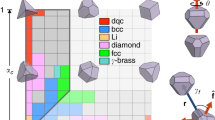Abstract
This article presents a theory of glass formation based on the mathematical description of agglomeration at the microscopic level. This theoretical model displays a nonnegligible predictive power when applied to the description of the medium-range order in binary covalent glasses such as borates, binary or ternary chalcogenide glasses, and the best known ternary silicon oxide-based glass. The mathematical approach used consists in spotting first the most stable elementary configurations in glass, treated asbuilding blocks, then a careful counting of all types of clusters containing many such entities and evaluation of the number of different pathways leading to their formation. The probabilities of cluster forming are then computed taking into account the multiplicities (statistical factors) and the Boltzmann factors related to the different energetic costs of various agglomeration processes. The probabilities of characteristic features observed in a given glass (e.g., boroxol rings, edge-sharing or vertex-sharing doublets of rings) are then computed; finally, a system of nonlinear equations can be produced by requiring the time derivatives of these probabilities to vanish, which can be interpreted as thesaturation or thestationary regime of the agglomeration process attained at a relatively early stage of glass formation that also corresponds tominimum fluctuations. The most important result of this type of modeling is the correct prediction of the glass transition temperature dependence on modifier concentration.
Similar content being viewed by others
References
Phillips, J.C., Topology of Covalent Non-Crystalline Solids: I. Short-Range Order in Chalcogenide Alloys,J. Non-Cryst. Solids, 1979, vol. 34, no. 2, pp. 153–181.
Phillips, J.C., Topology of Covalent Non-Crystalline Solids: II. Medium-Range Order in Chalcogenide Alloys and a-Si(Ge),J. Non-Cryst. Solids, 1981, vol. 43, no. 1, pp. 37–77.
Collins, R.,Proc. Phys. Soc, 1964, vol. 83, p. 553.
Kosterlitz, J.M. and Thouless, D.J., Ordering, Metastability, and Phase Transition in Two-Dimensional Systems,J. Phys. C: Solid State Phys., 1973, vol. 6, pp. 1181–1203.
Bray, P.J., NMR Studies of the Structures of Glasses,J. Non-Cryst. Solids, 1987, vol. 95/96, pp. 45–60.
Barrio, R.A., Castillo-Alvarado, F.L., and Galeener, F.L., Structural and Vibrational Model for Vitreous Boron Oxide,Phys. Rev. B: Condens. Matter, 1991, vol. 44, pp. 7313–7320.
Galeener, F.L., Barrio, R.A., Martinez, E., and Elliott, R.J., Vibrational Decoupling of Rings in Amorphous Solids,Phys. Rev. Lett, 1984, vol. 53, no. 25, pp. 2429–2432.
Thorpe, M.F., Continuous Deformations in Random Networks,J. Non-Cryst. Solids, 1985, vol. 75, pp. 355–360.
Thorpe, M.F., Bulk and Surface Floppy Modes,J. Non-Cryst. Solids, 1995, vol. 182, pp. 135–142.
Myuller, R.L.,Z. Phys. Chem., 1930, vol. 150 A, no. 5/6, pp. 439–475.
Myuller, R.L.,Electrical Conductivity of Vitreous Substances, New York: Consultants Bureau, 1971.
Porai-Koshits, E.A. and Andreev, N.S., Low-Angle Scattering by Glasses,Nature, 1958, vol. 182, no. 4631, pp. 335–336.
Porai-Koshits, E.A., The Structure of Glasses,J. Non-Cryst. Solids, 1977, vol. 5, nos. 1–3, pp. 86–128.
Dembovsky, S.A. and Koz’min, P.A., Order, Disorder, and Geometrical Information Indices of Molecules,Russ. Chem. Bull., 1996, vol. 45, no. 8, pp. 1810–1827.
Balmakov, M.D., Configurational Entropy of the Vitreous State,Fiz. Khim. Stekla, 1996, vol. 22, no. 4, pp. 485–501 [Glass Phys. Chem. (Engl. Transl.), 1996, vol. 22, no. 4, pp. 344–355].
Tveryanovich, Yu.S., Low-Temperature Paramagnetism of Glasses: The MnS-GaS1.5-GeS2 System,Fiz. Khim. Stekla, 1994, vol. 20, no. 4, pp. 461–466 [Glass Phys. Chem. (Engl. Transl.), 1994, vol. 20, no. 4, pp. 311–314].
Kerner, R. and dos Santos, D.M., Nucleation and Amorphous and Crystalline Growth: A Dinamical Model in Two Dimensions,Phys. Rev. B: Condens. Matter, 1988, vol. 37, no. 8, pp. 3881–3893.
Kerner, R. and Micoulaut, M.,C. R. Acad. Sci., Ser. II, 1992, vol. 315, p. 1307.
Kerner, R., A Model for Formation and Structural Properties of Alkali Borate Glasses,J. Non-Cryst. Solids, 1991, vol. 135, pp. 155–170.
Kerner, R. and Micoulaut, M., A Theoretical Model of Formation of Covalent Binary Glasses: I. General Setting,J. Non-Cryst. Solids, 1994, vol. 176, no. 2/3, pp. 271–279.
Kerner, R., Model of Rings in the Amorphous SiO2,J. Non-Cryst. Solids, 1995, vol. 182, pp. 9–21.
Barrio, R.A., Kerner, R., Micoulaut, M., and Naumis, G.G., Evaluation of the Concentration of Boroxol Rings in Vitreous B2O3 by the Stochastic Matrix Method,J. Phys.: Condens. Matter, 1997, vol. 9, pp. 9219–9234.
Dos Santos-Loff, D.M., Micoulaut, M., and Kerner, R., Statistics of Boroxol Rings in Vitreous Boron Oxide,Eur. Lett, 1994, vol. 28, no. 8, pp. 573–578.
Zachariasen, W.H., The Atomic Arrangement in Glass,J. Am. Ceram. Soc, 1932, vol. 54, no. 10, pp. 3841–3851.
Zarzycki, J.,Les verres et l’état vitreux, Paris: Masson, 1982.
Elliott, S.R.,Physics of Amorphous Materials, Longman Scientifical & Technical, 1990.
The Physics and Technology of Amorphous SiO 2, Devine, R.A.B., Ed., New York: Plenum, 1987.
Feltz, A., Aust, H., and Blayer, A., Glass Formation and Properties of Chalcogenide Systems: XXVI. Permittivity and the Structure of Glasses AsxSe1 -x and GexSe1-x,J. Non-Cryst Solids, 1983, vol. 55, pp. 179–190.
Micoulaut, M., Kerner, R., and dos Santos-Loff, D.M., Statistical Modeling of Structural and Thermodynamical Properties of Vitreous B2O3,J. Phys. C: Solid State Phys., 1995, vol. 7, no. 42, pp. 8035–8052.
Kerner, R. and Micoulaut, M., A Model of Glass Transition in Binary and Ternary Glasses,J. Mol. Liq., 1997, vol. 71, pp. 175–181.
Kerner, R., A Theory of Glass Formation, inAtomic Diffusion in Disordered Materials, Balkanski, M. and Elliott, R.J., Eds., New York: World Scientific, 1998, pp. 25–85.
Author information
Authors and Affiliations
Additional information
Continuation, see also the preceding issue. The publication of the Proceedings will be continued in the next issue of the journal.
The article was submitted by the author in English.
Rights and permissions
About this article
Cite this article
Kerner, R. Mathematical models of glass formation. Glass Phys Chem 26, 313–324 (2000). https://doi.org/10.1007/BF02731992
Issue Date:
DOI: https://doi.org/10.1007/BF02731992




